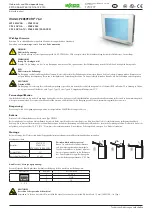
114
en | Multifunction power supply, large | PRA-MPS3
PRAESENSA
2019.11 | V1.00 |
Installation manual
Bosch Security Systems B.V.
4.
Connect the open end of the black cable (O) to the negative battery terminal, with the
eyelet of the temperature sensor (J) on top. Depending on the type of battery and its
terminals, use a short M8 bolt (P), spring washer (R) and washer (S), or short M6 bolt
(T), spring washer (V) and washer (W).
–
M8 and M6 are the most common screw terminal types for VRLA batteries in PA/VA
applications. Check the battery specification for the optimum tightening torque.
5.
Connect the open end of the red cable (N) to the positive battery terminal using a short
bolt, spring washer and washer (M8: P, R, S / M6: T, V, W). Tighten with the correct
torque, according to the battery specification.
Using a circuit breaker
Instead of using the 100
A
CF8 fuse (M) that is delivered with the unit, it is possible to use a
thermal or electro‑magnetic circuit breaker. The circuit breaker can also serve to manually
disconnect the battery from the PRA-MPS3. This could be convenient to power off a system
for making modifications after installation of the battery. It is important to make sure that the
breaking capacity of the circuit breaker is bigger than the short‑circuit current of the installed
battery. The short‑circuit current of typical batteries for the PRA-MPS3 is 2 to 6
kA. Circuit
breakers for 100
A for DC are available with a breaking capacity of 10
kA, both for panel
mounting and for DIN‑rail mounting.
The internal resistance of a 100
A circuit breaker is about the same as for the 100
A
CF8 fuse
(M), less than 1
mohm, so the impedance measurement of the battery circuit, which is a
requirement of the voice alarm standards, is not affected. Do not use multiple fuses or circuit
breakers in series or double‑pole circuit breakers, as this will increase the impedance of the
battery circuit and may generate a premature battery fault.
Battery cables
Battery cables are packed with the PRA-MPS3. These are heavy duty red (N) and black (O)
cables of 120
cm length, with a cross section of 35
mm
2
(approximately AWG
2) and with
crimp eyelet terminals attached. The wire resistance of each cable is approximately 0.7
mohm
(together 1.4
mohm). It is important to keep the resistance of the battery circuit very low for
the 12
V battery to be able to supply large (peak) currents without much voltage drop to the
DC/DC converters for the amplifiers. For that reason only a single fuse with a resistance of 0.5
to 1
mohm is allowed. The supplied 100
A
CF8 fuse (M) has a cold resistance of 0.6
mohm.
The battery itself has an internal resistance that depends on the capacity of the battery. A
new, charged 200
Ah battery (VRLA) of 12
V has an internal resistance of approximately
3
mohm.
When the supplied battery cables cannot be used, it is possible to use alternative cables, as
long as the total wire resistance remains below 2
mohm, and the lower it is, the better. That
value is for a PRA-MPS3 with three amplifiers connected, each loaded with 600
W of
loudspeakers. But even when less amplifiers are connected or less loudspeaker load is
connected, it is still good to select a cable type and length that fits to a maximum
configuration. Then, amplifiers and load can be added later without having to change battery
cables.
Summary of Contents for PRAESENSA
Page 1: ...PRAESENSA Public Address and Voice Alarm System en Installation manual ...
Page 2: ......
Page 193: ......
















































